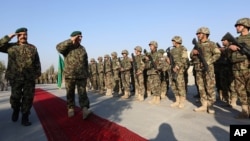Afghanistan’s army chief has cited “issues in leadership” and “few aircraft” for heavy casualties his forces suffered in recent clashes with Taliban insurgents, particularly in a northeastern region bordering Pakistan.
Chief of Army Staff General Sher Mohammad Karimi made the statement in Kabul while briefing a parliamentary committee on internal security.
The special meeting was called to discuss Friday’s deadly Taliban assault against several security posts in Badakhshan province that left at least 20 Afghan soldiers dead and many more wounded. Lawmakers representing the province quoted the number of dead and wounded soldiers at around 70.
General Karimi told the meeting as many as 250 Taliban insurgents took place in the assault in Jarom district with the support of local villagers.
“Soldiers bravely fought. There are issues in leadership, [the] commander of the unit was not available at the time of the attack,” the Afghan general said.
Spring offensive
The sudden eruption in hostilities in remote mountainous Badakhshan province, considered a relatively safe and peaceful Afghan region, is seen by many as the start of the traditional spring fighting in the country when snows melt, allowing greater movement of insurgents and weapons.
But a Taliban spokesman, Zabihullah Mujahid, told VOA the group had not launched a spring offensive.
"When our offensive is launched it will be formally announced," he said.
The spokesman said the Taliban policy on holding talks with the Afghan government remains unchanged, it wants all foreign forces to leave the country before holding peace talks with a government that is “sovereign” and “free of any external pressure."
He said Afghanistan "is still occupied and the American military has extended its stay."
For years, Afghan forces long have relied on American-led international ground and air support to deal with the insurgents. This year only a fraction of that military power, however, will be available to them because the bulk of foreign forces withdrew in December.
Rising civlian casualties
There are fears 2015 could be the most violent fighting season since the conflict began in 13 years ago.
The United Nations earlier this week warned that civilian casualties from ground battles rose by eight percent in the first three months of this year compared to the same period in 2014. Through the end of March, it said,136 civilians have died, while 385 have been wounded.
General Karimi said the army has mounted weapons on transport helicopters for use in clashes with insurgents.
He went on to acknowledge that while “the number of terrorists and threats” is increasing in the country, the airpower available to the Afghan National Army is limited to a “few aircraft.”
But the Afghan army chief assured lawmakers his forces are preparing to undertake a major clearing operation in Badakhshan in response to the deadly Taliban attack.
Interior Minister Noor-ul-Haq Olomi also briefed the parliamentary committee on overall security situation in Afghanistan. He said of 34 Afghan provinces, 11 are “facing high security threats while nine are under medium threat.”
He did not elaborate and again alleged that foreigners are behind the rise in attacks around the country.
Olomi added that militants fleeing counter-insurgency army operations in neighboring Pakistan have crossed to the Afghan side of the border to strengthen militant ranks in his country and joined insurgents to step up violence. He said an effort apparently is being made to move the fighting from the south to relatively peaceful northern parts of the country. Southern Afghan provinces are where Taliban insurgents are more active.







